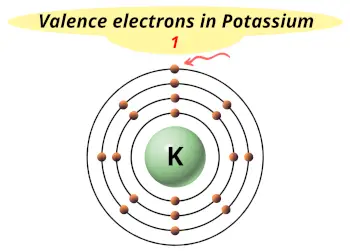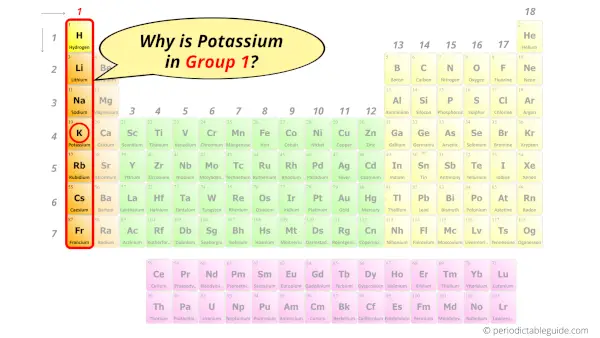
This is a SUPER easy guide on Potassium element.
In fact, the table mentioned below is the perfect information box (Which gives you every single detail about the Potassium element in Periodic table.)
So if you want to know anything about Potassium element, then this guide is for you.
Let’s dive right into it!
Potassium Element (K) Information
| Appearance |  Silvery gray |
| State (at STP) | Solid |
| Position in Periodic table |  Group: 1, Period: 4, Block: s |
| Category |  Alkali metals |
| Atomic number or Protons | 19 |
| Neutrons | 20 |
| Electrons | 19 |
| Symbol | K |
| Atomic mass |  39.098 u |
| Electrons arrangement or Bohr model |  2, 8, 8, 1 |
| Electronic configuration | [Ar] 4s1 |
| Atomic radius |  275 picometers (van der Waals radius) |
| Valence electrons |  1 |
| 1st Ionization energy | 4.341 eV |
| Electronegativity |  0.82 (Pauling scale) |
| Crystal structure |  BCC (Body-centered cubic) |
| Melting point | 336.7 K or 63.5 °C or 146.3 °F |
| Boiling point | 1032 K or 759 °C or 1398 °F |
| Density | 0.856 g/cm3 |
| Main isotope | 39K |
| Who discovered Potassium and when? |  Humphry Davy in 1807 |
| CAS number | 7440-09-7 |
Potassium in Periodic table
Potassium element is in group 1 and period 4 of the Periodic table. Potassium is the s-block element and it belongs to alkali metals group.
| H | He | ||||||||||||||||
| Li | Be | B | C | N | O | F | Ne | ||||||||||
| Na | Mg | Al | Si | P | S | Cl | Ar | ||||||||||
| K | Ca | Sc | Ti | V | Cr | Mn | Fe | Co | Ni | Cu | Zn | Ga | Ge | As | Se | Br | Kr |
| Rb | Sr | Y | Zr | Nb | Mo | Tc | Ru | Rh | Pd | Ag | Cd | In | Sn | Sb | Te | I | Xe |
| Cs | Ba | La* | Hf | Ta | W | Re | Os | Ir | Pt | Au | Hg | Tl | Pb | Bi | Po | At | Rn |
| Fr | Ra | Ac** | Rf | Db | Sg | Bh | Hs | Mt | Ds | Rg | Cn | Nh | Fl | Mc | Lv | Ts | Og |
| *Ce | Pr | Nd | Pm | Sm | Eu | Gd | Tb | Dy | Ho | Er | Tm | Yb | Lu | ||||
| **Th | Pa | U | Np | Pu | Am | Cm | Bk | Cf | Es | Fm | Md | No | Lr |
←Move to: Argon (Ar) element – Periodic Table
→Move to: Calcium (Ca) element – Periodic Table
Why is Potassium in Group 1?

Do you know, how many electrons can be accommodated in the first shell, second shell, third shell, fourth shell, etc…?
Here is the table showing the capacity of orbits to hold electrons.
Number of electrons in shells.
| Orbit / Shell (n) | Maximum no. of electrons this orbit can hold |
| K shell, n = 1 | 2 × 1² = 2 |
| L shell, n = 2 | 2 × 2² = 8 |
| M shell, n = 3 | 2 × 3² = 18 |
| N shell, n = 4 | 2 × 4² = 32 |
Thus,
- 1st shell can hold 2 electrons.
- 2nd shell can hold 8 electrons.
- 3rd shell can hold 18 electrons.
- 4th shell can hold 32 electrons.
Now the atomic number of potassium (K) is 19.
Hence the electron arrangement in potassium is 2, 8, 8, 1. And the electron configuration of potassium is 1s2 2s2 2p6 3s2 3p6 4s1.
This electron arrangement and electron configuration indicates that the outermost orbit (i.e orbit number 4) of potassium element has 1 electron.
Hence, it lies in group 1.
Why is Potassium in Period 4?

Let me ask you a question.
How many shells does potassium have?
It’s 4. Right?
You have already seen the bohr model of potassium atom in the above table.
From the Bohr model, it can be found that the number of orbits or shells in potassium is 4. Hence, as potassium has 4 orbits, it lies in period 4 of the Periodic table.
Why is Potassium in s-block?

Before knowing this reason, first of all I want to ask you a simple question.
How can you determine the blocks-wise position of elements?
The simple answer: The elements will lie in the s, p, d or f block will completely depend upon the subshell in which the last electron will enter.
For example; the electron configuration of potassium is [Ar] 4s1.
So the last electron of potassium enters the s-subshell or s-orbital.
Hence, potassium is the s-block element.
8 Interesting facts about Potassium
Interesting facts about potassium element are mentioned below.
- Potassium is the 7th most abundant element found in the earth’s crust.
- Around 2.4% of the earth crust is made up of potassium element.
- The dead sea contains a large amount of potassium in it.
- Potassium is a soft alkali metal that can be cut even with a kitchen knife.
- Potassium is also present in the human body.
- Deficiency of potassium in the human body can cause a fetal disease called hypokalemia.
- Potassium is the very first metal that was discovered by using the electrolysis process.
- Potassium is a metal, but it floats on water (as it is lighter than water).
Properties of Potassium
The physical and chemical properties of potassium element are mentioned below.
Physical properties of Potassium
Physical properties of potassium are mentioned below.
- Potassium is a solid Silvery gray colored metal. It tarnishes very quickly if kept open in the air and becomes dull grey in color.
- The melting point of potassium is 63.5 °C and its boiling point is 759 °C.
- Potassium has many isotopes, but out of them 39K has an abundance of around 93%.
- Density of potassium is less than the density of water. Hence it floats on water.
- Potassium is the 2nd lightest metal after lithium.
Chemical properties of Potassium
Chemical properties of potassium are mentioned below.
- Potassium is a very reactive alkali metal and hence it is always stored in a mineral oil.
- Potassium is highly reactive to water. When potassium comes in contact with water, it explodes with a violet flame.
- Due to very high chemical reactivity of potassium element, it is not found in free state. But it is always found as a compound with other elements.
- When potassium reacts with water, it makes the solution alkaline and releases the hydrogen gas as well as heat.
Uses of Potassium
Uses of potassium are mentioned below.
- In industries, potassium is used for making fertilizers, oxidizers, etc.
- Potassium is also used in manufacturing of glass, soap, gunpowder and bleaching agents.
- Potassium bisulphate (which is a compound of potassium) is used to preserve beverages like wine and beer.
- Potassium bromide which is a white crystalline salt has some medicinal applications as well as it is also used in photography.
- Fruits like nuts, potatoes, tomatoes, etc contain potassium in it. So these foods are used for maintaining a healthy body.
Explore our New Interactive Periodic Table (with Rotating Bohr Models and More)

Details about this Periodic table:
- Access detailed info on all elements: atomic mass, electron configurations, charges, and more.
- View rotating Bohr models for all 118 elements.
- Get a free HD image of the Periodic Table.
Note: For future use, bookmark this Periodic table or visit “PeriodicTableGuide.com”
External resources:
- Potassium – Element information, properties and uses | Periodic Table. (n.d.). Potassium – Element Information, Properties and Uses | Periodic Table. https://www.rsc.org/periodic-table/element/19/potassium
- Potassium – Wikipedia. (2019, April 17). Potassium – Wikipedia. https://en.wikipedia.org/wiki/Potassium
- P. (n.d.). Potassium | K (Element) – PubChem. Potassium | K (Element) – PubChem. https://pubchem.ncbi.nlm.nih.gov/element/Potassium
- It’s Elemental – The Element Potassium. (n.d.). It’s Elemental – the Element Potassium. https://education.jlab.org/itselemental/ele019.html
